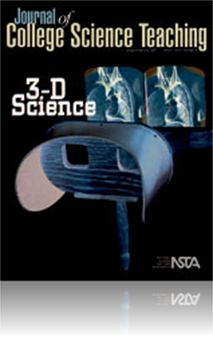All Journal of College Science Teaching resources
Journal Article
Favorite Demonstration: E-Concept Mapping
Not all demonstrations involve using exciting visual displays of one or a series of scientific principles. Demonstrations can be as simple as showing the interrelationship between scientific concepts or principles using concept maps. Concepts maps ar...
Journal Article
Core concepts can be integrated throughout lower-division science and engineering courses by using a series of related, cross-referenced laboratory experiments. Starting with butane combustion in chemistry, we expanded the underlying core concepts of...
Journal Article
Research and Teaching: Small-Group Peer Teaching in Introductory Biology Classroom
All teachers want their students to learn, enjoy, and be engaged in their classes. A good way to create such results is to incorporate active learning approaches into classrooms. Many teachers, however, do not know how to start making these changes a...
Journal Article
To adequately prepare future faculty for their multiple roles as researchers, teachers, and colleagues, innovative teaching opportunities must be made available to doctoral students that allow them to maintain a high level of research productivity ...
Journal Article
Using Science Fiction Movie Scenes to Support Critical Analysis of Science
This article discusses the pedagogical advantages and challenges of using science-fiction movies and television shows in an introductory science class for elementary teachers. Two instructional episodes are described in which scenes from the movies R...
Journal Article
Society for College Science Teachers: Finding Time Through Specialization
As part of the Early Career Development Program at the Institute of Teaching and Learning Excellence, colleagues presented a segment entitled Managing My Course. Among the key points was the notion that effective classroom management helps provide t...
Journal Article
Teaching Anatomy and Physiology Using Computer-Based, Stereoscopic Images
Learning real three-dimensional (3D) anatomy for the first time can be challenging. Two dimensional drawings and plastic models tend to over-simplify the complexity of anatomy. The approach described uses stereoscopy to create 3D images of the proces...
Journal Article
Favorite Demonstration: Using a Demonstration for an End-of-Semester Review
Demonstrations are an ideal way to end a course, and can be much more than a fun or even memorable diversion before the intense week of final exams. When paired with an in-class worksheet, they can serve as an excellent course review mechanism, offer...
Journal Article
This article presents an approach for integrating instruction of scientific writing and reading into undergraduate science courses, inspired by the pedagogical theory of cognitive apprenticeship. Included, is a demonstration of its implementation and...
Journal Article
Retaining Undergraduate Women in Science, Mathematics, and Engineering
The purpose of this research study was to examine the effectiveness of a program in retaining women in science, mathematics, and engineering majors. Undergraduate women participating in a support and mentoring program were compared with nonprogram ...
Journal Article
Performing inquiry should enhance the intellectual development of students on numerous levels. We evaluate whether inquiry-based activities elicit inquiry behaviors by comparing these activities with traditional review sessions. We find that both inq...
Journal Article
The process of a successful undergraduate student-faculty research collaboration involving a student with documented learning disabilities is detailed. As the student developed research skills, she also learned how to develop her own learning strateg...




